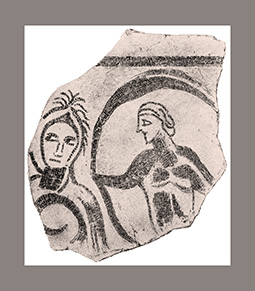scarica l’articolo in formato .pdf: Arione a Comiso? Nuove osservazioni sulle terme romane di Piazza Diana
Un largo tratto di mosaico a tessere bicrome raffigurante parte di due figure umane affiancate fu scoperto nel 1935 nei pressi di Piazza Diana a Comiso, nell’area dove negli anni successivi (scavi Pace 1937 e Di Stefano 1988-89) sarebbero stati messi in luce i resti di un edificio termale con due fasi architettoniche sovrapposte, databili rispettivamente alla media e alla tarda età imperiale. Gli interrogativi relativi alla identificazione iconografica delle figure e alla collocazione originaria del mosaico costituiscono lo spunto per un revisione del complesso architettonico termale e del contesto insediativo entro il quale era inserito. Le due figure sono probabilmente da identificare con Arione e una Nereide ed erano verosimilmente poste nel frigidarium della prima fase del complesso. L’edificio, la cui estensione e monumentalità appaiono sproporzionate rispetto alle modeste dimensioni dell’insediamento in età medioimperiale, era probabilmente connesso ad un santuario legato al culto delle sorgenti dell’Ippari, come suggeriscono da un lato gli spunti iconografici del mosaico e la protome animalesca in marmo del cosiddetto “Hipparis”, dall’altro alcuni cenni delle fonti letterarie.
A large fragment of a black and white floor mosaic representing two human figures, was discovered in 1935 near Piazza Diana in Comiso, in the same area where, in the following years (1937 Pace’s excavations, and 1988-89 Di Stefano’s excavations), the remains of a roman bath with two architectural phases, respectively dating back to the 2nd and 5th cent. AD, were brought to light. Starting from the discussion on the iconography of the figures and on their original positioning, a general reexamination is proposed of the roman bath and of the surrounding settlement. The two figures are tentatively identified with Arion and a Nereid; probably, they were originally placed in the frigidarium of the first phase of the building. Furthermore, the bath complex, whose dimension and monumentality appear very large and disproportionate if compared to the modest extension of the surrounding settlement in the 2nd century, was probably connected with a sanctuary linked to the cult of the Ippari springs, as suggested on the one hand by some iconographical elements of the frigidarium mosaic and by the marble protome of the so called “Hipparis”, and on the other hand by some mentions in the ancient literary sources.

